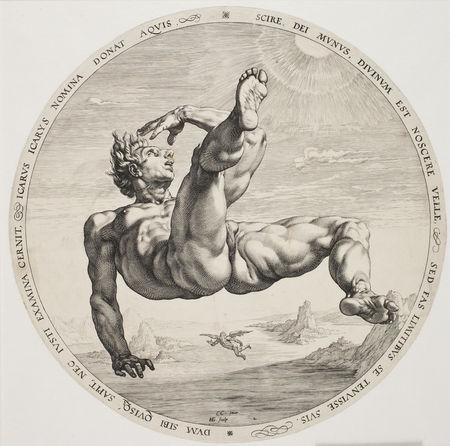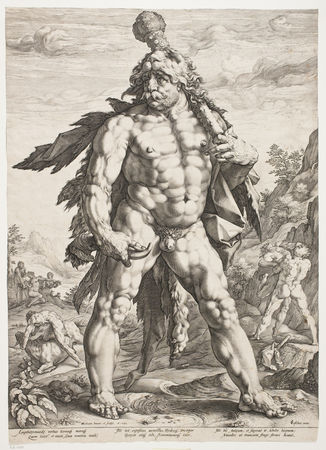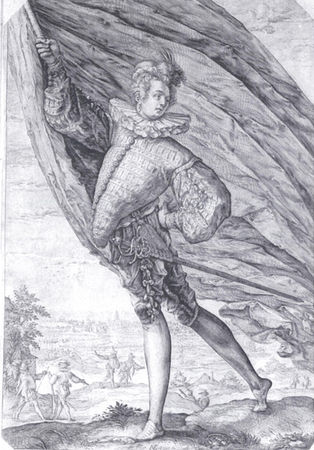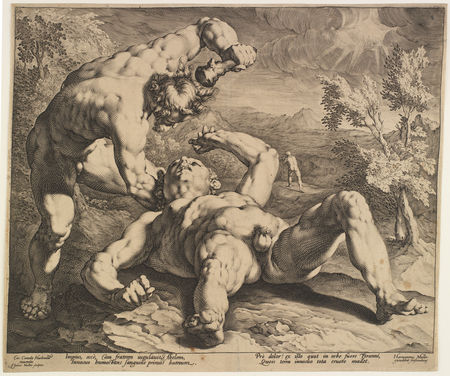'The Artful Image' @ the National Gallery of Denmark
Hendrick Goltzius (1558 - 1617) The Four Disgracers – Ikaros. The Royal Collection of Prints and Drawings,1588
An overlooked but captivating chapter in European art will unfold when The Royal Collection of Prints and Drawings focuses on these very early years in Dutch art. With a rich selection of graphic works by the Haarlem mannerists, the exhibition portrays a generation of artists who preceded what we now tend to consider the golden age of Dutch painters. Refinement, virtuosity and extreme visual effects take centre stage in the exhibition's more than 70 works. They bear witness to artistic production that not only rivalled the excellence of Rembrandt and company, but also proved indispensible to them. At the same time, the exhibition focuses on the Haarlem mannerists’ approach to graphic art’s double role as a means of both reproduction and independent artistic expression in which artists working in an atmosphere of creative competition would often succeed in surpassing both one another and the originals from which they worked, and in doing so also succeeded in bringing entirely new methods to graphic art.
Hendrick Goltzius (1558 - 1617) The Large Hercules. The Royal Collection of Prints and Drawings, 1589
Flourishing Haarlem
After becoming free from Spanish control, Haarlem grew in the 1580s into one of the leading artistic centres in the young Republic of the Netherlands. Central to this blossoming prosperity were artists such as Karel van Mander, Cornelis Cornelisz van Haarlem, and, not least of all, Hendrick Goltzius. Together they formed a study circle devoted to Haarlem Mannerism, as it became known. Their particular pictorial language was characterised by a strong awareness of style and cultivated elegance, not to mention a pursuit of an expression that prioritised artful ingenuity over naturalism. Their work depicted exaggeratedly brawny musclemen, violent drama, wild fantasy, and a rare richness of detail. Publication of these engravings meant at the same time that the Haarlem mannerists’ works quickly became accessible to many, and at a low price, and so their distinguishing trademarks were also passed down to subsequent generations of Dutch artists. The dissemination of graphic works also went hand in hand with the dawning theorisation of art that characterised the 16th century
Hendrick Goltzius (1558 - 1617) The Great Standard-Bearer. The Royal Collection of Prints and Drawings, 1587
Original and copy
The exhibition at the National Gallery of Denmark makes copper engraver and publisher Hendrick Goltzius (1558-1617) its natural focal point. It was in his workshop that the Haarlem artists developed their unique engraving style, and it was his publishing house that published the majority of prints at the highpoint of Haarlem mannerism. Together with colleagues and students, Goltzius personally reproduced a long series of artworks by international masters, especially Italians. But, as the exhibition shows, reproduction engraving by the Haarlem mannerists rapidly turned into a special and independent art form, in which the graphic artist was judged on his degree of technical inventiveness and ability to interpret the original whilst adding in his own artistic expertise and creativity to the work. The engravers competed amongst one another and their prints soon attained a paradoxical degree of independence underpinned by the fact that many contemporaneous painters used them as models for their own works. When looking at Danish ecclesiastical art from 1580-1700, one again sees Haarlem-inspired imagery occurring in the form of carved or painted figures in numerous altarpieces, pulpits and epitaphs.
Jan Harmensz Muller (1571 - 1628) Cain Killing Abel. The Royal Collection of Prints and Drawings, c. 1589
From the collection of Christian IV
The exhibition in the National Gallery of Denmark shows a total of 72 works, a selection of the sought-after collection of Dutch graphic art in the Royal Collection of Prints and Drawings, supplemented with individual works from the museum’s painting and sculpture collection. The museum’s collection of Dutch mannerism was established under Christian IV, who, in keeping with the international fashion at royal courts of the time, had his castle decorated with mannerist art obtained almost exclusively from the Netherlands.
Hendrick Goltzius (1558 - 1617) The Dragon devouring the companions of Cadmus. The Royal Collection of Prints and Drawings, 1588
The Royal Collection of Prints and Drawings
With the exhibition “The Artful Image. The Haarlem Mannerists 1580-1600,” the National Gallery of Denmark continues its series of exhibitions and publications focusing on the artistic fields represented in the Royal Collection of Prints and Drawings. With two annual retrospective exhibitions and accompanying catalogues, it is the museum’s ambition to further highlight the multifaceted nature of art on paper. The exhibitions and the catalogues will all be based on the museum’s research and the rich collection of more than 240,000 drawings, graphic works and photographs currently included in the Royal Collection of Prints and Drawings. In other words, the exhibitions trace an impressive streak of artworks spanning 700 years, which in several of the exhibitions will be put into perspective with important loans from other institutions both in Denmark and abroad. The revitalisation of The Royal Collection of Prints and Drawings was initiated last spring with Jakob S. Boeskov’s exhibition “Siggimund”, and next year the museum will be following up with exhibitions of Danish and international photography, along with drawings and graphics by Picasso.
National Gallery of Denmark. 10 October 2009 – 17 January 2010

/https%3A%2F%2Fprofilepics.canalblog.com%2Fprofilepics%2F1%2F0%2F100183.jpg)
/https%3A%2F%2Fstorage.canalblog.com%2F03%2F02%2F119589%2F96711876_o.jpg)
/https%3A%2F%2Fstorage.canalblog.com%2F11%2F31%2F119589%2F94773502_o.jpg)
/https%3A%2F%2Fstorage.canalblog.com%2F20%2F83%2F119589%2F94772815_o.jpg)
/https%3A%2F%2Fstorage.canalblog.com%2F26%2F72%2F119589%2F75604929_o.jpg)
/https%3A%2F%2Fstorage.canalblog.com%2F59%2F60%2F119589%2F26458628_o.jpg)







/http%3A%2F%2Fstorage.canalblog.com%2F73%2F33%2F119589%2F129591594_o.jpg)
/http%3A%2F%2Fstorage.canalblog.com%2F66%2F61%2F119589%2F128472566_o.jpg)
/http%3A%2F%2Fstorage.canalblog.com%2F11%2F20%2F119589%2F127268174_o.jpg)
/http%3A%2F%2Fstorage.canalblog.com%2F34%2F98%2F119589%2F117635941_o.jpg)